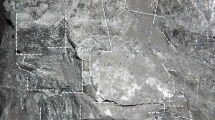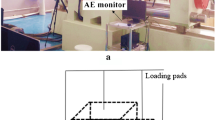Abstract
This research investigates how inserting notched gypsum filling between granite specimens affects their breakage under uniaxial compressive testing. Various thicknesses of gypsum filling slabs were placed between granite specimens, incorporating different dimensions and notch configurations. The investigated parameters include elastic modulus, Poisson’s ratio, uniaxial compressive strength, and Brazilian tensile strength of 5 GPa, 0.18, 7.4, and 1 MPa, respectively. Compression testing, at an axial load rate of 0.05 mm/min, was conducted on a total of 9 different models. Numerical simulations were performed on models with notched gypsum filling, varying thicknesses, and notch angles using Particle Flow Code in 2D. The results demonstrated that breakage behavior was primarily influenced by filling thickness and notch angle. The uniaxial compressive strengths in samples were found to be affected by fracture patterns and the breakage mechanism of the filling. The study revealed that the behavior of discontinuities is influenced by the number of induced tensile cracks, which increase with thicker filling. Acoustic emission (AE) hits during loading’s initial phase, a rapid increase in AE hits before the applied stress reached its peak, and significant AE hits accompanying each stress drop were observed. The breakage patterns and strengths were found to be similar in both experimental and numerical approaches.
























Similar content being viewed by others
References
He MC (2002) Soft rock engineering mechanics. Science Press, Beijing
Salamon MDG (1968) Elastic moduli of a stratified rock mass. Int J Rock Mech Min Sci Geomech Abstr 5:519–527
Taliercio A, Landriani GS (1988) A failure condition for layered rock. Int J Rock Mech Min Sci Geomech Abstr 25:299–305
Amadei B, Pan E (1992) Gravitational stresses in anisotropic rock masses with inclined strata. Int J Rock Mech Min Sci Geomech Abstr 3:225–236
Yong MT, Ming CK (2001) A failure criterion for transversely isotropic rocks. Int J Rock Mech Min Sci 38:399–412
Yong MT, Ming CK, Juang CH (2006) An experimental investigation of the failure mechanism of simulated transversely isotropic rocks. Int J Rock Mech Min Sci 43:1163–1181
Huang S, Ding X, Wu A, Lu B, Zhang Y (2012) Study of multi-joint constitutive model of layered rock mass and experimental verification. Chin J Rock Mech Eng 31(8):1627–1635
Han B, Wang Z, Ding X, Ping X (2007) Numerical simulation for rheologic characteristics of interbedded strata of soft and hard rock. J Yangtze River Sci Res Inst 24(2):25–29
Xiong L, Yang L (2011) Numerical analysis for viscoelasto-plastic rheological property of interlayered rock mass. Chin J Rock Mech Eng 30(Sup1):2803–2809
Ladanyi B, Archambault G (1975) Shear strength and deformability of filled indented joints. Final report - third year, École Polytechnique de Montréal
Phien-wej N, Shrestha UB, Rantucci G (1990) Effect of infill thickness on shear behaviour of rock joints. Rock joints, Barton and Stephansson (eds), Balkema, pp. 289–294
De Toledo PEC, De Freitas MH (1993) Laboratory testing and parameters controlling the shear strength of filled rock joints. Geotechnique V43(1):1–19
Papaliangas T, Hencher SR, Lumsden AC, Manolopolou S (1993) The effects of frictional fill thickness on the shear strength of rock discontinuities. Int J Rock Mech Min Sci Geomech Abst 30(2):81–91
Lama RD (1978) Influence of clay filling on shear behaviour of joints. Proc 3rd Congr Int Assoc Eng Geol Madrid 2:27–34
Cleary PW, Pereira GG, Lemiale V, Piane CD, Clennell MB (2016) Multiscale model for predicting shear zone structure and permeability in deforming rock. Comput Part Mech 3:179–199
Lanari M, Fakhimi A (2015) Numerical study of contributions of shock wave and gas penetration toward induced rock damage during blasting. Comput Part Mech 2:197–208
Oñate E, Zárate F, Miquel J et al (2015) A local constitutive model for the discrete element method. Application to geomaterials and concrete. Comput Part Mech 2:139–160
Rojek J (2014) Discrete element thermomechanical modelling of rock cutting with valuation of tool wear. Comput Part Mech 1:71–84
Donzé FV, Bouchez J, Magnier SA (1997) Modeling fractures in rock blasting. Int J Rock Mech Min Sci 34:1153–1163
Scholtès L, Donzé FV (2013) A DEM model for soft and hard rocks: role of grain interlocking on strength. J Mech Phys Solids 61:352–369
Duriez J, Darve F, Donzé FV (2013) Incrementally non-linear plasticity applied to rock joint modelling. Int J Numer Anal Meth Geomech 37:453–477
Duriez J, Scholtès L, Donzé FV (2016) Micromechanics of wing crack propagation for different flaw properties. Eng Fract Mech 153:378–398
Jiang Y, Xian X, Xu J, Xiong D (2004) A research on sandstone uniaxial and triaxial compression tests. China Min Mag 13:66–69
Uzun Yaylacı E, Oner E, Yaylacı M, Ozdemir ME, Abushattal A, Birinci A (2022) Application of artificial neural networks in the analysis of the continuous contact problem. Struct Eng Mech 84(1):35–48. https://doi.org/10.12989/SEM.2022.84.1.035
Yaylacı M, Öner E, Adıyaman G, Öztürk Ş, Uzun Yaylacı E, Ahmet B (2023) Analyzing of continuous and discontinuous contact problems of a functionally graded layer: theory of elasticity and finite element method. Mech Based Des Struct Mach. https://doi.org/10.1080/15397734.2023.2262562
Yaylacı M, Uzun Yaylacı E, Ozdemir ME, Ozturk S, Sesli H (2023) Vibration and buckling analyses of FGM beam with edge crack: Finite element and multilayer perceptron methods. Steel Compos Struct 46(4):565–575
Uzun Yaylacı E, Yaylacı M, Ozdemir ME, Terzi M, Ozturk S (2023) Analyzing the mechano-bactericidal effect of nano-patterned surfaces by finite element method and verification with artificial neural networks. Adv Nano Res 15(2):165–174. https://doi.org/10.12989/ANR.2023.15.2.165
Ozdemir ME, Yaylacı M (2023) Research of the impact of material and flow properties on fluid-structure interaction in cage systems. Wind Struct 36(1):31–40
Golewski GL (2023) (2023a) Mechanical properties and brittleness of concrete made by combined fly ash, silica fume and nanosilica with ordinary Portland cement. AIMS Mater Sci 10(3):390–404
Golewski GL (2023) Concrete composites based on quaternary blended cements with a reduced width of initial microcracks. Appl Sci 13(12):7338. https://doi.org/10.3390/app13127338
Golewski GL (2023) The phenomenon of cracking in cement concretes and reinforced concrete structures: the mechanism of cracks formation, causes of their initiation, types and places of occurrence, and methods of detection—a review. Buildings 13(3):765. https://doi.org/10.3390/buildings13030765
Golewski GL (2023) Effect of coarse aggregate grading on mechanical parameters and fracture toughness of limestone concrete. Infrastructures 8(8):117. https://doi.org/10.3390/infrastructures8080117
Chen C (2017) Experimental study on time-dependency of rock under uniaxial compressive load. Dissertation, Chongqing University
Jing L, Hudson JA (2002) Numerical methods in rock mechanics. Int J Rock Mech Min Sci 39:409–427
Jing L (2003) A review of techniques, advances and outstanding issues in numerical modelling for rock mechanics and rock engineering. Int J Rock Mech Min 40:283–353
Karampinos E, Hadjigeorgiou J, Hazzard J, Turcotte P (2015) Discrete element modelling of the buckling phenomenon in deep hard rock mines. Int J Rock Mech Min Sci 80:346–356
Bai QS, Tu SH, Zhang C (2016) DEM investigation of the fracture mechanism of rock disc containing hole(s) and its influence on tensile strength. Theor Appl Fract Mech 86:197–216
Cundall P (1971) A computer model for simulating progressive large-scale movement in block rock systems. In: Proceedings of international symposium on fracture, ISRM, Nancy, 11–18
Cundall PA, Strack ODL (1979) A discrete numerical model for granular assemblies. Geothechnique 29:47–65
Donzé FV, Richefeu V, Magnier SA (2008) Advances in discrete element method applied to soil, rock and concrete mechanics. Electron J Geotech Eng 8:1–44
Tran VT, Donzé FV, Marin P (2011) A discrete element model of concrete under high triaxial loading. Cem Concr Compos 33:936–948
Potyondy D (2007) The effect of voids on the mechanical properties of rock. In: Proceedings of the discrete element modeling conference(DEM2007), 27–29 Aug, Brisbane, Australia
Zhang Q, Wang X, Tian L (2018) Analysis of mechanical and acoustic emission characteristics of rock materials with double-hole defects based on particle flow code. Shock Vib 32(1):23–35
Acknowledgements
This work was financially supported by National Natural Science Foundation of China (Grant No. 51608117), Major Science and Technology Project of Henan Province (No. 231100220700), and Key research projects of colleges and universities in Henan Province (No.24A410002).
Author information
Authors and Affiliations
Contributions
Jinwei Fu contributed to visualization and software. Vahab Sarfarazi contributed to supervision and formal analysis. Hadi Haeri: contributed to data curation and writing—original draft preparation. Saeed Delfan contributed to visualization, investigation, and software. Reza Bahrami contributed to software and investigation. Xiao Wang contributed to investigation.
Corresponding author
Ethics declarations
Conflict of interest
The authors have no conflicts of interest to declare that are relevant to the content of this article.
Additional information
Publisher's Note
Springer Nature remains neutral with regard to jurisdictional claims in published maps and institutional affiliations.
Rights and permissions
Springer Nature or its licensor (e.g. a society or other partner) holds exclusive rights to this article under a publishing agreement with the author(s) or other rightsholder(s); author self-archiving of the accepted manuscript version of this article is solely governed by the terms of such publishing agreement and applicable law.
About this article
Cite this article
Fu, J., Sarfarazi, V., Haeri, H. et al. Acoustic emission and breakage mechanism analysis on gypsum-filled granite specimens with varying notch dimensions under uniaxial compression testing. Comp. Part. Mech. (2024). https://doi.org/10.1007/s40571-024-00738-7
Received:
Revised:
Accepted:
Published:
DOI: https://doi.org/10.1007/s40571-024-00738-7




